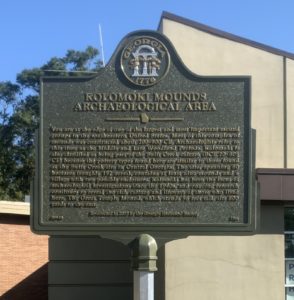This week’s #MarkerMonday highlighted Benjamin Hawkins, Indian Agent to the Creeks during the late 18th century. To further explore Native American history in Georgia, GHS invites you to take part in an online historical marker scavenger hunt exploring the people, places, and events, that shaped our state and nation’s history.
To get started, use the Georgia Historical Marker Online Database to find answers to the questions! You can access the online database by following this link. Once there, search all of Georgia’s markers by keyword, location, region, time period, subject, and marker program to answer the following questions. For a quick tutorial on how to use the Georgia Historical Marker Online Database, click here.
Click the toggle below to access the Native American History in Georgia Scavenger Hunt.
[toggles id="Scavenger Hunt"] [togglegroup] [togglehead id="Scavenger Hunt" tab_id="0"]Native American History in Georgia Scavenger Hunt[/togglehead] [togglebody tab_id="0"] Click here for a printable version of the online scavenger hunt. Once you complete the scavenger hunt, check your answers here!!
- This person served as Oglethorpe’s chief interpreter and ran a successful trading post near the Savannah River.
- Answer:
- Which marker did you use to find the answer?
- Who is credited as creating the first written form of the Cherokee language?
- Answer:
- Which marker did you use to find the answer?
- During this battle between Creek Indians and Spanish Apalachees, the Creeks arranged blankets around a campfire to trick the Apalachees into attacking empty blankets.
- Answer:
- Which marker did you use to find the answer?
- Tomochichi was the mico of what tribe?
- Answer:
- Which marker did you use to find the answer?
- Which treaty voided Native American land claims east of the Mississippi River?
- Answer:
- Which marker did you use to find the answer?
- This Scotch-Coweta chief was killed by the Upper Creeks after ceding Creek lands west of the Flint River to whites.
- Answer:
- Which marker did you use to find the answer?
- This line located in Banks County served as the boundary between Georgia and the Cherokee Nation.
- Answer:
- Which marker did you use to find the answer?
- Located eight miles from Decatur, this location shows archaeological evidence of how Native Americans created stone bowls.
- Answer:
- Which marker did you use to find the answer?
- This location was home to Major Ridge and served as the site where the Treaty of New Echota was negotiated.
- Answer:
- Which marker did you use to find the answer?
- This group of Native Americans migrated to Georgia from North Carolina to participate in the turpentine industry.
- Answer:
- Which marker did you use to find the answer?
- This large mound site was built during the Middle and Late Woodland periods.
- Answer:
- Which marker did you use to find the answer?
- This city served as the capital of the Cherokee Nation and was home to the first Native American newspaper office, the Cherokee Phoenix.
- Answer:
- Which marker did you use to find the answer?
- This town, which was later burnt by the Spaniards in the 17th century, was mentioned in the travel narratives of de Soto.
- Answer:
- Which marker did you use to find the answer?
- Native Americans from the Archaic period are thought to have created petroglyphs on six soapstone boulders at this site. What is the name of the site and what is a petroglyph?
- Answer:
- Which marker did you use to find the answer?
[/togglebody] [/togglegroup] [/toggles]

